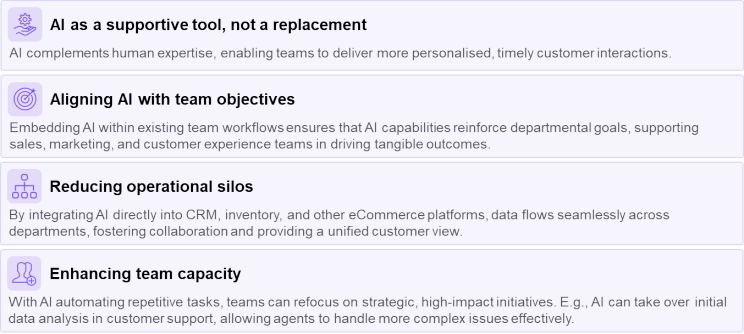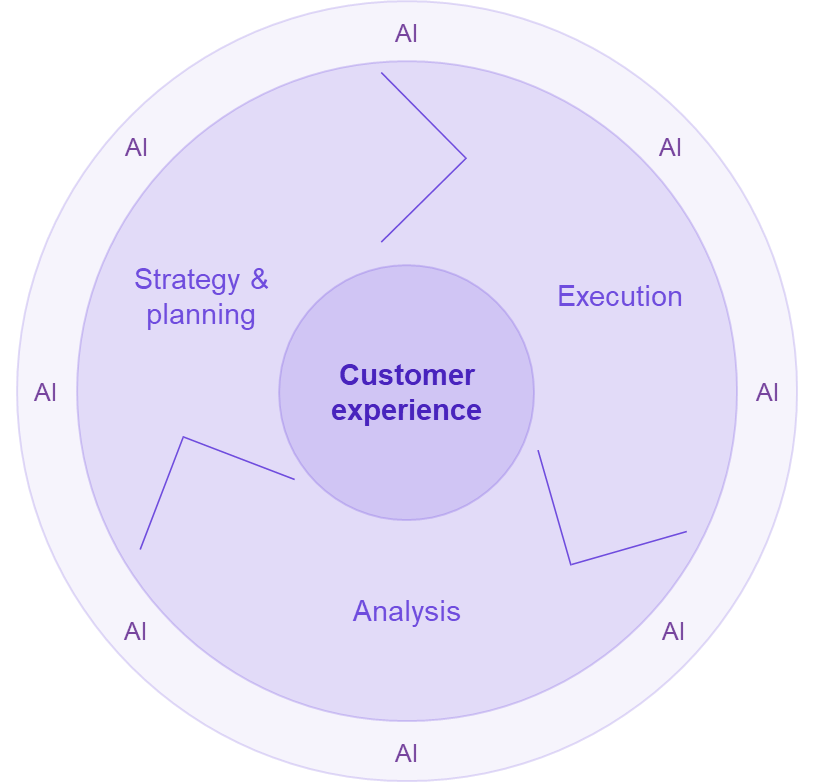Setting your baseline - Integrating AI into core business operations.
When looking at how to operationalise and realise the opportunity AI presents to your eCommerce operations, AI should not be seen as a separate function or team; it should be embedded across business-as-usual (BAU) processes. By weaving AI into operations and decision-making, from customer service and marketing to supply chain and product management, businesses avoid creating unnecessary silos and ensure that AI serves as an enhancement rather than an isolated project.
Expectation setting is key. Build a clear understanding of your baseline; where do you want to be across all key aspects of the eCommerce customer lifecycle (purchase, order fulfilment, onboarding & support, repurchase)? Think back to our lamp hunting customer, what are all the key scenarios we would like to set an exceptional baseline experience for them? Having this vision enables you to effectively map where current AI capabilities can augment and enable these areas.
eCommerce is a tried and tested model, leading with a product-led mindset. Market-standard eCommerce experiences have achieved their product-market fit; they are validated experiences that consumers actively engage with millions of times daily.
So why spend your precious time, investment, and resources trying to push the boundaries on unvalidated concepts and experiences within the retail and eCommerce sphere using AI, when you haven’t effectively hit the baseline yet? That said, each business, retailer, and product is different, with different customer types and commercial models. AI presents a great opportunity to better understand these differences and personalise your customer experience and operating models accordingly.
Not to say that there isn’t significant value in experimenting with new concepts and customer experiences, validating and scaling what works with your current and new audiences, but do so from a stable and agile position to be able to accomplish this effectively.

Forbes reports that; ‘78% of eCommerce brands have already implemented AI in their stores or plan to do so’.
But the jury is still out on the effectiveness of this implementation, whether these brands have been able to effectively operationalise this and realise the benefits.

Technology
As mentioned in the first part of the article, the concept of 'tech without the trading' raises further issues around the costs and benefits associated with any AI transformation. This includes the costs of technologies and platforms required, additional headcount, skill sets, workflows, and training needed to operationalise AI, alongside the clear business risk of not seeing a return on investment.
Enterprise-level eCommerce technology suites, such as Adobe or Salesforce, already possess extensive AI capabilities to support the type of operational transformation highlighted. These capabilities are integrated across their end-to-end eCommerce lifecycle tools, including commerce and CRM lifecycle technologies. However, many of these tools are drastically underutilised, with their capabilities developing at a rate that eCommerce retailers cannot keep up with to fully operationalise. Thankfully, these vendors and their integration partners come embedded with strategic and operational talent to support and enable this growth, so help is on hand.
In line with the core theme of this article, this transformation does not need to be done in one fell swoop. Capabilities and efficiencies via AI can be delivered incrementally, depending on what best suits your organisation. Whether that means leveraging the technology stack already in place, addressing an underperforming part of the customer journey (whether related to commercial, performance, or trading indicators), or focusing on an area that is greatly inhibiting your teams, incrementally augmenting what is already there with AI, rather than replacing it with large-scale transformation, provides a range of benefits. At the heart of it is minimising cost and risk.
Data.
Like any team or capability, the resources, setup and support you provide are key ingredients for success. AI relies heavily on access to high-quality data across the customer journey. Key data types include:
Customer Data:
- Behavioural: Browsing history, support interactions, purchase history
- Profile: Demographic information, contact preferences, location
Strategic Data Models:
- Customer profiles and segments
- Next likely purchase predictions
- Predicted support needs
- Purchase and distribution modelling
Capturing and distributing this data across the journey enables AI to produce actionable insights, helping businesses understand customer needs and preferences while driving strategic growth.
AI is not only valuable for leveraging data but also for enhancing how it's captured. Instead of relying on static methods, like a simple newsletter signup box or banner triggered by specific actions, AI can dynamically optimise the data capture process. By recognizing patterns in user behaviour, AI-driven solutions can intelligently trigger personalised requests, gathering valuable data at moments when customers are most receptive.
Risks.
Whilst AI introduces significant opportunities, it also brings risks that must be managed carefully:
- Security: With increased data capture comes the need for rigorous security measures. Studies show that brands prioritising privacy have a 12% higher customer loyalty rate than those that don’t. A secure infrastructure and rigorous customer consent practices are paramount.
- Value exchange: Customers need to perceive tangible value in exchange for sharing data.
- Accuracy: when utilising AI to support and automate certain functions, ensuring the accuracy of information is pivotal, whether that being through effectively understanding customer queries or ensuring the access to the right data. McKinsey has reported that;‘44% of organisations have experienced negative consequences from generative AI’s inaccuracy’.
- Authenticity: AI interactions should enhance, not detract from, genuine, humanised brand experiences.
Future Opportunities.
As organisations build a strong AI foundation, they can explore more advanced applications, particularly in merging physical and digital experiences. Customer support is one area ripe for innovation: AI-driven chatbots, for example, now extend beyond simple Q&A, providing personalised, context-aware guidance through product setup and troubleshooting. Emerging integrations with smart devices, such as Amazon Alexa and Google Home, promise even richer customer experiences, enabling brands to interact directly in customers' everyday environments.
By continuously evolving AI applications, eCommerce businesses can remain agile, adapting to new trends while delivering seamless, engaging customer experiences that set them apart in a dynamic market.
The operational benefits have already been covered in detail here, but even moving to aspects such as content production, which has traditionally been heavily reliant on experienced digital designers, AI presents the option for them to take a more supervisory and governance-led role. AI offers the opportunity to move past the tedious process of producing individual assets for every single product colour, accessory, and combination. Designers can now focus on creating a robust framework for producing assets to support trading.
The next frontier with AI provides new levels of personalisation for customers. With intuitive, almost human-like interactions, AI can have engaging and relevant conversations with customers to understand more about them, their wants, needs, and problems, truly getting to know customers. However, as discussed in the risk framing, a mutual value exchange is crucial, where customers are actively engaged in the value they receive from providing their information.
Forrester has reported that ‘10% of companies are expected to invest in AI-driven digital content creation over the next year’.
Going back to our trusty lamp and homeware example, AI provides even more levels of styling within your room, ensuring it fits alongside the room setup, providing other homeware recommendations to complement your lamp, and ensuring you’re getting the right bulb and energy recommendations. In fashion retail, this has even more applications and impact.
Conclusion
In conclusion, there is an enormous opportunity to leverage the potential that AI provides in the eCommerce and retail space, both now and in the future, to enhance customer experiences, streamline operations, and naturally the commercial benefits will present themselves across the board.
By establishing a robust and agile infrastructure, with AI augmenting, not replacing, teams and functions, organisations can streamline and drive themselves to bigger and better things.
From your beloved customer getting their perfect lamp and engaging with your brand for life, to your team feeling engaged and sustainable in their work, improving employee wellbeing, retention rates, and team performance.
To business performance, where you can effectively trade and react to an ever-competitive market and evolving customer expectations.The opportunities are unrivalled, but in a market that is competitive as ever, the margin for error for tech without the trading is rapidly shrinking.
Sources:
- Khris Digital. (2025).65 Essential AI in E-commerce Statistics To Know In 2025. Retrieved fromhttps://khrisdigital.com/ai-in-e-commerce-statistics/
- Forbes. (December 2022).How AI is disrupting the content creation economy. Retrieved fromhttps://www.forbes.com/councils/forbestechcouncil/2022/12/09/how-ai-is-disrupting-the-content-creation-economy/
- McKinsey & Company. (2025).The state of AI. Retrieved fromhttps://www.mckinsey.com/capabilities/quantumblack/our-insights/the-state-of-ai
- Forrester. (2022).Predictions 2023: AI Will Become An Indispensable, Trusted Enterprise Coworker. Retrieved fromhttps://www.forrester.com/blogs/predictions-2023-ai/
- Spill. (February 2024).64 workplace burnout statistics you need to know for 2024. Retrieved fromhttps://www.spill.chat/mental-health-statistics/workplace-burnout-statistics






